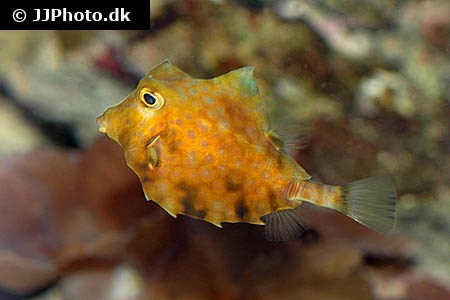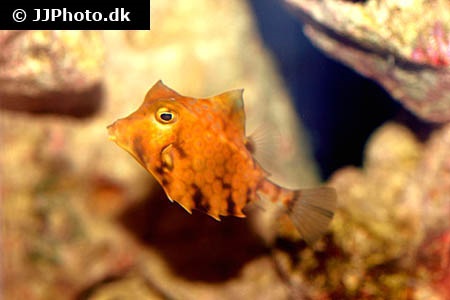Tetrosomus gibbosus


| Latin name | Tetrosomus gibbosus - (Linnaeus, 1758) |
|---|---|
| Local name | Humpback turretfish |
| Family | Ostraciidae - Tetrosomus |
| Origin | East Indian Ocean, West Indian Ocean, Australia, Japan, The Red Sea, Indonesia, New Zealand, Central/West Pacific |
| Max length | 30 cm (11.8") |
| Minimum volume |
2000 l (528 gal) |
|---|---|
| Hardiness |
Unknown |
| Suitable for aquarium |
Suitable with care |
| Reef safe |
Not reef safe |
| Aggressiveness | Unknown |
| Recommended |
Small crustaceans (Krill, mysis, artemia...) Zooplankton (Cyclops, pods...) |
|---|---|
| Mostly |
Larger crustaceans (Shrimp, crabs...) Other invertebrates |
This species likes to eat tubeworms.
This species poses a threat towards shrimps and crabs etc., which are relatively small.
This species has a toxin in its skin, which it releases when highly stressed or dying.
This poison can kill all the aquatic life in the aquarium, if unlucky.
This species cannot maneuver in strong currents, especially so when small.
Pay particular attention to the pump’s water inlet as these fish in certain circumstances, can get stuck.
These fish eat exceptionally slowly and can be very selective feeders.
It can therefore be problematic to provide it with a sufficient and varied diet, in an aquarium with other, faster feeding species.
This species often has a fun and interesting personality.
This species needs good hiding places, for example, between live rocks.
Boxfish(Ostraciidae) have a unique square shape and a particular way of swimming.
They have a rather special personality, which one quickly comes to love.
Boxfish live typically off a mixture of algae, coral polyps, zooplankton, and in some cases crustaceans.
They are not normally reef safe and when small will require gentle water circulation.
Boxfish can secrete a poison when stressed or if they die, which can in the worst case, kill the contents of a whole aquarium.
Never use the water the fish was transported in.
| Distribution | Indo-West Pacific: Red Sea (Ref. 3141) and East Africa to Indonesia, north to southern Japan, south to northern Australia. Immigrated into the southeastern Mediterranean through the Suez Canal. |
|---|---|
| Danish common names |
Trekantet kuffertfisk |
| English common names |
Humpback turretfish Hunchback turretfish |
| French common names |
Poisson-coffre pyramide |
Bob Fenner. The Puffers Called Box-, Cowfishes, family Ostraciidae - Wet Web Media - (English)
Richard Aspinall. 2012. Oddballs for the Marine Aquarium - Tropical Fish Hobbyist - (English)

